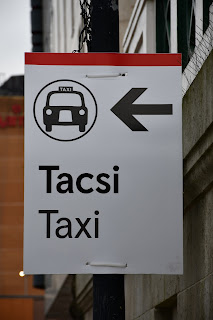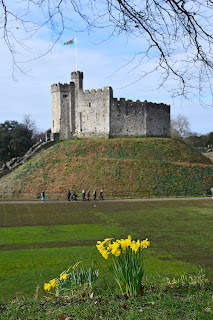Cardiff
I do not know whether I was told this or simply made it up, but one of the best times to visit Cardiff is when the daffodils are in bloom. As the national flower of Wales, they grow everywhere from parks to castles and figure very prominently on all kinds of tourist knickknacks. I planned mine and Johnny’s trip precisely for this time. Since morning train tickets are cheapest on Saturdays (and that by a wide margin), our choice of date was set. It was also set well in advance, as tickets become more expensive the longer one waits. Of course, this meant that we were left at the whims of the weather, and as the day of the trip drew near, the forecast did not look particularly auspicious.
Nevertheless, we stuck to our plan. We had
both been looking forward to the trip – so much so, in fact, that a whole
eleven days before the journey, Johnny gave me a bunch of budding daffodils
(Sainsbury’s sells clumps of daffodils for one pound which, because they have
not yet flowered, look more like clusters of asparagus). They had reached full
bloom by the time we had set off, boding well for our trip.
We reached Cardiff on a cloudy late
morning, making our way to the city’s castle. On our way, we noticed a number
of stalls selling Welsh and English memorabilia – daffodil hats, hats with
dragons on them, flags, and so on. Only then did it begin to dawn on me that
the day we had chosen for our trip was not an entirely fortunate one: Cardiff
was to host a rugby match between England and Wales that very afternoon. Luckily,
this did not affect much of the day’s itinerary, as the sports fans only
started to trickle in later. By the time they did so, we had already fled the
centre.
Cardiff Castle was much more interesting
than I expected it to be. All I had seen of it in pictures was its central
tower perched atop a mound abloom with daffodils. The interior decorations,
however, were fascinating. The library and halls have kept their ornate
decorations from the nineteenth century, many of them inspired by the “exotic”
artistic styles of the Muslim World and Asia. Indeed, one of the rooms had an
entire ceiling in the style of Moorish architecture. Fortifications on the site
of Cardiff Castle date back all the way to the first century, when the area was
settled by Romans. Cardiff Castle proper, however, was only built in the
eleventh century by either William the Conqueror or Robert Fitzhamon, the Earl
of Gloucester. It is famous for, among other things, being the site of the
execution and quartering of Welsh independence fighter Llywelyn Bren in 1316.
After making our loop around the castle, we
walked north to take a look at the Edwardian Baroque-style City Hall. Having
found the Welsh Government building rather unimpressive, we walked back south
again, where we took a bus to Llandaff Cathedral. Severely damaged during the
Second World War, the cathedral underwent a remarkable reconstruction, with a
horizontal arch being placed at the nave to support a statue called Christ
in Majesty. The rest of the “drum” on which Christ stands is decorated with
smaller golden angels and saints. Also interesting is the number of medieval
pieces of art scattered around the building.
We did not find much to eat around the
cathedral and time was running out to see the next attraction on our list, so
we bought some pastries at a nearby shop and ate them at the bus stop. I had a
Welsh cake, which to my surprise was not really a cake but more of a sweet, light
biscuit. I quite liked it. I also had a bara brith, a type of Welsh fruit cake.
I am not sure – and the server did not know either – what makes it different
from other types of cakes, nor indeed why it looks so dark. It was quite good
nonetheless, though I would sooner die of shame than serve someone as crumbly a
piece as the one I was given.
The next place on our itinerary was Castell
Coch, a spooky attraction about an hour’s journey removed from Llandaff
Cathedral. Taking the bus to Morganstown, we walked through the suburban Welsh
boonies for half an hour, with the castle looming within our sight until we
stood at the very foot of the hill. Although from the outside, it looks like it
might well belong to Count Dracula, the interior of Castell Coch is remarkably
ornate and bears much similarity to the orientalist influences of Cardiff
Castle. In fact, the castle is an imaginative 19th century
reconstruction of what was by then a desolate ruin, its owners taking broad
creative license with this Welsh Disneyland.
By the time we left Castell Coch, we knew
we would not make it to Caerphilly Castle within opening hours. This was
particularly sad to me, as I was riding on a high of having saved a little over
two pounds on tickets to Castell Coch thanks to my English Heritage membership.
However, we decided to go anyway, and the weather soon rewarded our pluckiness.
As we rode over, we saw sunlight falling on one hill after another, awakening
the muted green and bronze fields. When we arrived at Caerphilly, the sky was a
beautiful shade of blue, making up entirely for the fact that the castle was
closed.
As we returned to Cardiff, Johnny had the
presence of mind to make a dinner reservation; we would need to eat dinner
relatively early to make the last train back. We spent some time at the harbour
as the darkness fell, making a loop around the Welsh Millennium Centre, the
Pierhead Building, the Senedd, and the Norwegian Church Arts Centre. Cardiff
has a quite numerous Norwegian community owing to maritime trade and it is the
birthplace of children’s book author Roald Dahl.
Having eaten dinner at a reasonable but not
leisurely tempo, we walked back to the train station at an increasingly hurried
pace. Weaving our way through streets littered with drunk football fans turned
out to take more time than Google Maps expected, not to mention that the
evening closure of shopping malls cut off the fastest routes. None of this,
however, prepared us for the shock that awaited us upon arriving at the train
station: the place was packed. Makeshift corridors were channelling crowds of
visitors to the platforms for their destinations, with the one for London
stretched hopelessly far.
We dutifully joined the end of the
impossible queue and waited as policemen walked around handing out sweets from big
buckets. As we began to search for accommodation, however, the line suddenly
started to move. I did not think the momentum would last, but the queue kept
moving and moving until we somehow found ourselves on the platform and inside
the train. Of course, we could not sit down, but having made that discovery
relatively early, we positioned ourselves nicely in the corridor. Squeezed by
slightly inebriated teens, I read my book of Welsh poetry until we arrived in
Oxford.


























































Comments
Post a Comment